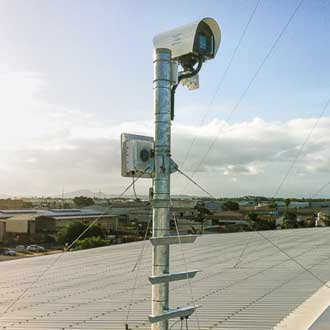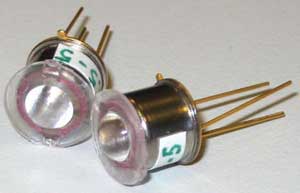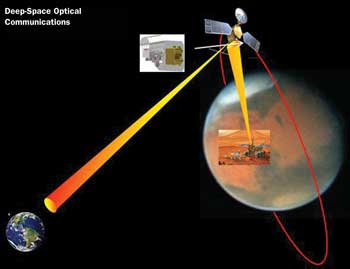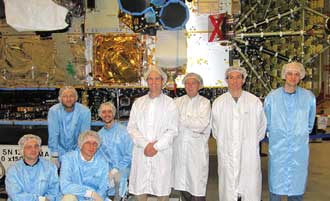Light-based options promise to pick up where radio-frequency technology leaves off.
In wireless communications, things are getting crowded. Growing data demands are bumping up against radio frequency capacity.
In response, researchers and companies are looking into using infrared, visible and ultraviolet light to provide point-to-point communication through air, space and water. The connection can function indoors and out, between chips, around the Earth or across the solar system. The technology has low power requirements and offers high capacity and resistance to electromagnetic interference. Thanks to tightly confined beams, there can be unlimited reuse of unregulated spectrum and inherent security.

Mounted atop buildings and other structures, a free-space optical system with four lasers and a radio backup connects points together.
“The time has come to seriously consider other viable options for wireless communication, using the upper parts of the electromagnetic spectrum for applications where access to huge bandwidth is a requirement,” said Murat Uysal, an associate professor of electrical and electronics engineering at Ozyegin University in Istanbul. He heads OPTICWISE, a European Science Foundation-funded group of more than 80 researchers from 20 European countries that investigates all areas of optical wireless
communications.
To date, despite its advantages and having been around for years, optical wireless has been overshadowed by radio frequency (RF) technology, which has dropped in price while increasing throughput. However, growing data demands may finally make optical communications an attractive contender.

Researchers at the University of Warwick have developed antenna modules that enhance the sensitivity and selectivity of optical wireless receivers.
A source, a detector and a way to align the two are fundamental to any optical communications system, noted Roger J. Green, a professor of electronic communications systems at the University of Warwick in Coventry, UK. Although all three areas are important, detectors often are the most critical because they usually have to operate in a photon-poor regime with meager noise margins. Warwick researchers have developed an optical antenna to aid in visible and infrared energy capture and are researching other innovations.
“We’re working on 3-D optoelectronic components for detection and signal processing using polymers,” Green said.
While researchers investigate what may become tomorrow’s products, there are free-space optical communications devices available today. For instance, in September 2012 fSona Networks Corp. of Richmond, British Columbia, Canada, announced a product offering 2.5-GB/s full-duplex bandwidth. It uses lasers that transmit at 1550 nm, a carefully chosen wavelength.

Free-space optics could link laptops in a building (top) or buildings (bottom) together, providing point-to-point high bandwidth.
“It’s really about eye-safety standards and being able to transmit at higher power, which means higher link margin and more photons per bit,” said Paul Erickson, fSona’s chief technical officer.
Being able to pump out more photons helps power through heavy rain and fog as well as overcome atmospheric turbulence. These anomalies disperse the beam and limit the distance between source and detector. In the case of fSona products, the maximum separation is about 2.5 km.
That distance is enough to enable one important application: Smartphones connect wirelessly back to base stations, which then must satisfy the total data demand. Base stations today often are located only 500 m or a kilometer apart, so they can be connected optically with high availability.
Ten years ago, fSona’s products offered 155-Mb/s capacity. Current technology supports 16 times that data rate. Near term, a further fourfold leap to 10 Gb/s is planned, Erickson said.
In November 2012, San Diego-based LightPointe Communications announced a 2.5-Gb/s product series with an equipment latency of less than 10 ns. Latency, or the lag, in communications is important in speed-sensitive applications, such as high-frequency trading.
Some of the challenges facing the technology involve alignment of source and detector, said LightPointe founder and CEO Heinz A. Willebrand. Towers may bend because of differential heating by the sun, and this can make beams move. Active tracking systems can overcome this effect, but most are too expensive for commercial applications. LightPointe uses four overlapping beams and a cost-effective wider-beam active tracking system.
Fog is a major challenge because of particles being about the same size as the wavelength of light. Willebrand has looked at wavelengths from 850 nm to 10 µm, but none result in an appreciable signal attenuation advantage.
What free-space optical communications does offer is bandwidth. The world record is 1.2 Tb, or 1200 Gb, per second. With the right setup, even higher speeds may be possible. The approach uses multiple wavelengths acting like separate channels. In this concept, the signals are sent down a fiber and launched through the air. Then they travel through a lens before ending up back in fiber.
“You have no electro-optical conversion. That is a system that will, of course, ultimately scale to extremely high bandwidth,” Willebrand said. He holds a patent on the idea.

Free-space optics can link rovers on distant planets to ground stations on Earth, offering many times higher bandwidth than is possible with current RF technology.
One solution to the degradation of the optical signal that can arise from atmospheric conditions is to combine optical and RF technologies. LightPointe has products that use this approach. Links are handled by lasers 99 percent of the time, with a switch to RF if weather conditions warrant, Willebrand said.
In space, attenuation disappears with the atmosphere. Alignment of source to detector, though, becomes more challenging, and pointing must be more precise. On top of that, satellites and spacecraft move with respect to each other and the ground.
There have been successful tests in space done over the past five years using laser communications terminals built by Tesat-Spacecom GmbH & Co. KG of Backnang, Germany. The company will supply free-space optical communications equipment over the next few years to the European Space Agency. These terminals will fly aboard low-Earth-orbiting and geosynchronous satellites, opening up a bottleneck.

This is the Tesat-Spacecom team that developed a laser communications terminal that can use free-space optics to link low-Earth-orbiting satellites to geosynchronous ones, thereby relieving a data bottleneck.
“The instruments onboard LEO Earth observation satellites record high-precision images leading to a massive data volume,” said Mark Gregory, Tesat laser communications terminal system engineer.
Because low-Earth-orbiting satellites whiz by, they’re generally in contact with ground stations for only 10 minutes or so. What’s more, some ground stations are in isolated areas. So getting the data off the satellites is a problem.
Optical connections solve this by enabling data rates of up to 1.8 Gb/s, six times the rate possible with RF. These links can be made to geosynchronous satellites that have constant high-capacity RF connections to the ground.
For scientific purposes, Tesat is building a high-altitude ground station equipped with adaptive optics. The station’s elevation puts it above most of the signal-absorbing atmosphere, and the adaptive optics will help mitigate the twinkling that distorts the incoming wavefront. The first optical downlink tests are expected to begin in the second half of this year.
Laser links from spacecraft to a ground station could be of great use for deep space operations, something being investigated by a team headed by Hamid Hemmati, supervisor of the optical communications group at the Jet Propulsion Laboratory (JPL) in Pasadena, Calif.
Thanks to high-definition imagers and other high-content sensors, rovers on Mars and other probes can generate enough data to overload radio links. As of 2012, the latest Mars rover was limited to a 6-Mb/s data rate, with the possibility of raising that to 25. In contrast, the JPL group is developing a terminal to up that rate to hundreds of megabits per second.
Achieving this requires lasers of the right peak and average powers, and differing demands require different detector approaches for space and ground. Those sources are the subject of current research, Hemmati said. In addition, there is a need for single-photon-sensitive detectors, with superconducting nanowire-based technology cooled to about 1 K for the ground. In space, a semiconductor-based photon-counting array will be used.
“Usually, the links are asymmetric. The downlink is a much higher rate than up. So we can live with not as good a detector array in space,” Hemmati said.
Beam pointing has to be within 30 millionths of a degree, an extremely tight spec that could be met, for example, through the use of a laser beacon from the ground. Vibrations on the spacecraft must be mitigated and the movement of the target over the time the beam travels accounted for.
With adequate funding, the JPL system might be ready for testing in space by 2018. As of now, NASA has been sponsoring only basic technology development and has not committed to a proof-of-concept demonstration from deep space.
Although free-space optics communication has prospects from the ground up, it faces a formidable competitor. RF technologies have proved adept at providing the right ratio of price and performance.
Joseph Kahn, a professor of electrical engineering at Stanford University in Palo Alto, Calif., has used free-space optical communications for years in a variety of projects. He likes the approach but has reservations about how its future will play out. For one thing, there are competing technologies. For another, some problems lie in the medium through which the light travels or in the setting in which it is used, and these may prove difficult hurdles to overcome.
“Not all the issues can be solved by better devices or technical developments,” Kahn said.
For more information and the latest headlines on free-space optics, visit Photonics.com.